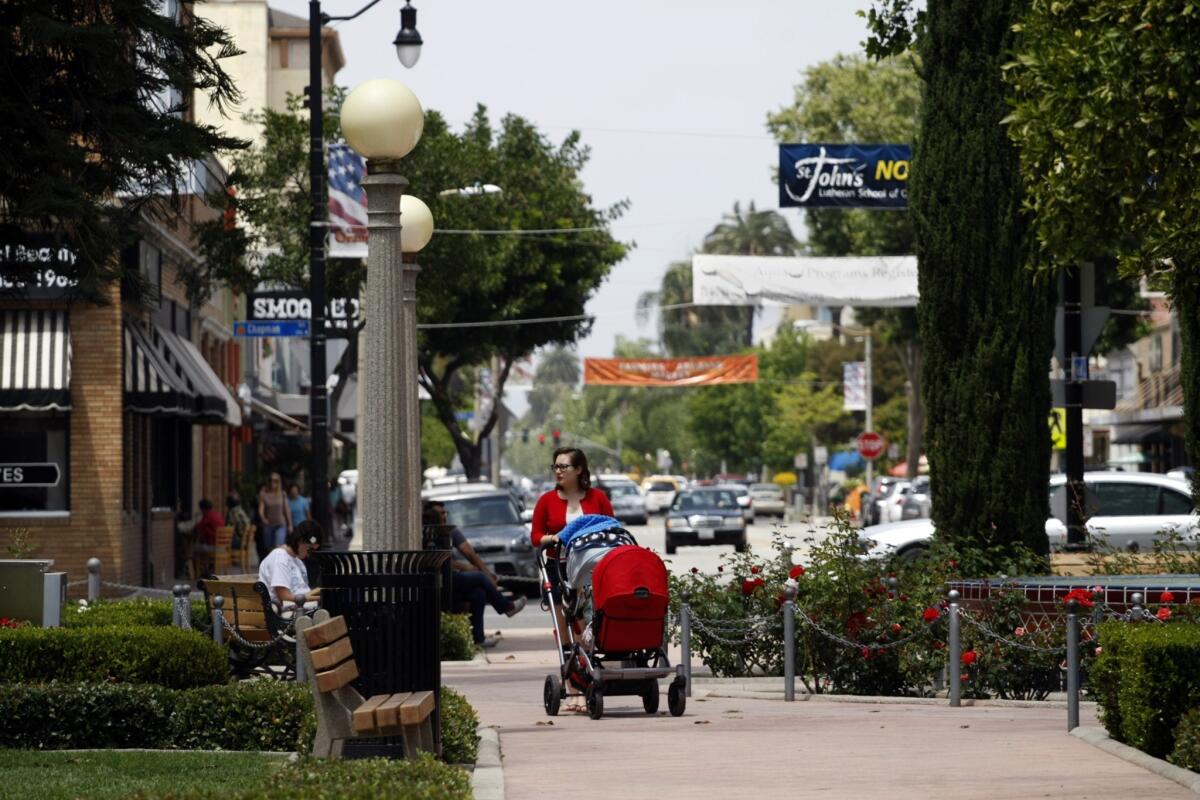Chapman University faces an uphill battle with neighbors over a plan to grow enrollment at Orange campus
- Share via
Chapman University has revived a scaled-down version of a plan to increase student enrollment, asking city officials to approve adding nearly 1,500 full-time students over the next decade.
Since 1989, the Chapman University Specific Plan has governed campus design standards, building heights and enrollment growth. The plan’s been amended by the Orange City Council six times as the college acquired land and sought to redevelop or rehabilitate aging buildings.
One factor that could soon allow increased enrollment: a new building that will house The Fowler School of Engineering is scheduled to open next fall, establishing programs in computer engineering, electrical engineering and computer science.
Chapman President Daniele Struppa said the board of trustees is committed to training students who can meet the demands of an increasingly and health-and-tech-oriented job market.
“We have focused our growth in areas we know are in high demand for our region, including engineering, technology and the health sciences,” Struppa wrote in a prepared statement. “We are not growing for the sake of national rankings, but rather growing to provide a much-needed workforce in high-demand fields — and doing it at a caliber only Chapman can do.”
Last year, Chapman doubled down on educating future engineers by opening the $130 million Keck Center for Science and Engineering, the largest construction project in its history.
Wylie Aitken, chairman of the board of trustees, said Chapman is going in a different direction: investing more in research instead of buildings.
“Everybody can take a bit of a deep breath because we have done most of the building we plan to do in our footprint in the city of Orange,” Aitken said.
Last month, Chapman outlined the development it plans to pursue over the next decade, including expanding and replacing old dormitories, opening a student film studio and theater, building an above-grade parking lot and expanding or replacing two aging academic buildings.

Orange residents say they recall Chapman leaders of the past promised an ultimate buildout, and yet student enrollment continues to grow.
“Housing needs to show up before the students do,” said Adam Duberstein of the Respect Orange neighborhood advocacy group. “If the community didn’t come together like they did in 2015, housing would not have been on Chapman’s radar.”
In 2015, residents marshaled unprecedented opposition to a proposal to increase student enrollment from 8,700 to 11,650.
After about four months of scathing Facebook threads and emotionally-charged neighbor meetings, Chapman paused the Specific Plan Amendment while it established and listened to a Neighborhood Advisory Committee consisting of residents, city officials and business owners.
The Committee met 24 times over the last four years to discuss student housing, off-campus party houses, law enforcement and future academic programs.
In 2017, Chapman took a little heat off Old Towne Orange and spent $150 million to buy the Chapman Grand apartments in Anaheim’s redevelopment area, the Platinum Triangle. University officials converted market-rate rentals into dorms for up to 900 students.
In August, students moved into the new, 400-bed residence hall, The K. The $47.4-million building allowed Chapman to require freshmen and sophomores to live in campus-owned housing, unless they live at home with a parent or guardian.
“I give them credit for all the housing they put together in two years, but if they want to grow they need to continue,” said Orange City Councilman Mike Alvarez, a Chapman critic.
Nevertheless, Duberstein said Chapman shouldn’t use the fact it acquired two new dormitory buildings as an excuse to enroll more students.
He would prefer Chapman obtain city approval for additional housing before asking to bring more students to Orange.
Chapman isn’t opposed to raising its goal of housing 50% of students in university housing, Aitken said. Some neighborhood advocates want at least 65%.
“We’d love that, all we have to do is work with the city to find the land,” Aitken said.
Arianna Barrios, a trustee of the Rancho Santiago Community College District who plans to run for Orange City Council, is disappointed that Chapman isn’t conducting a full environmental impact report and is instead relying on information compiled in 2015.
She’s also concerned that the timeline has the City Council voting on the proposal before new council members take office in December 2020.
“I think that that’s extremely dangerous for everyone involved because Old Towne Orange does not have an elected representative,” she said, explaining that the currently at-large council will soon reshape into districts for distinct neighborhoods. “The fact that you would push something forward that would affect one district, it says something about what you’re trying to do.”
All the latest on Orange County from Orange County.
Get our free TimesOC newsletter.
You may occasionally receive promotional content from the Daily Pilot.






